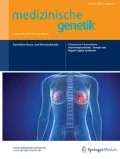Zusammenfassung
Bei den kongenitalen Strukturmyopathien handelt es sich um eine heterogene Gruppe seltener erblicher Myopathien, die durch charakteristische licht- oder elektronenmikroskopisch sichtbare morphologische Einschlüsse oder Umlagerungen von Zellorganellen in der Muskelfaser der quergestreiften Muskulatur gekennzeichnet sind. Die ersten Symptome werden in der Regel bereits bei der Geburt und/oder im Kindesalter, seltener mit einer milderen Symptomatik im Erwachsenenalter manifest. Der Verlauf ist in der Regel nur langsam progredient, sehr selten rasch fortschreitend. Die kongenitalen Strukturmyopathien werden derzeit nach histologischen, immunhistologischen, ultrastrukturellen und auch molekulargenetischen Gesichtspunkten eingeteilt. Eine wachsende Zahl von Gendefekten wird für die Muskelveränderungen verantwortlich gemacht, wobei sowohl die phänotypische Variabilität bei Mutationen im gleichen Gen als auch die genetische Heterogenität bei ähnlichem Phänotyp zu berücksichtigen sind. Zu den häufigsten Formen gehören die nemaline Myopathie, die Core-Myopathien, die zentronukleären Myopathien sowie die kongenitale Fasertypendisproportion.
Abstract
Congenital myopathies are a heterogeneous group of rare neuromuscular disorders, sometimes presenting as floppy infant syndrome but generally progressing slowly. They usually begin at birth or in childhood, rarely in adulthood. Congenital myopathies are classified according to their histological, immunohistological, and ultrastructural pattern and the underlying genetic defect. A growing number of causative genes have been identified in the last years. Several congenital myopathies reveal a remarkable phenotypic overlap. The most common congenital myopathies are the nemaline myopathies, core myopathies, centronuclear myopathies, and congenital fibre-type disproportion.



Literatur
Cardamone M, Darras BT, Ryan MM (2008) Inherited myopathies and muscular dystrophies. Semin Neurol 28:250–259
Clarkson E, Costa CF, Machesky LM (2004) Congenital myopathies: diseases of the actin cytoskeleton. J Pathol 204:407–417
D’Amico A, Bertini E (2008) Congenital myopathies. Curr Neurol Neurosci Rep 8:73–79
Finsterer J, Stoellberger C (2008) Primary myopathies and the heart. Scand Cardiovasc J 42:9–24
Jungbluth H, Wallgren-Pettersson C, Laporte J (2008) Centronuclear (myotubular) myopathy. Orphanet J Rare Dis 3:26
Laing NG (2007) Congenital myopathies. Curr Opin Neurol 20:583–589
Nicot AS, Toussaint A, Tosch V et al (2007) Mutations in amphiphysin 2 (BIN1) disrupt interaction with dynamin 2 and cause autosomal recessive centronuclear myopathy. Nat Genet 39:1134–1139
North K (2008) What’s new in congenital myopathies? Neuromuscul Disord 18:433–442
Peters SA, Kohler C, Schara U et al (2008) Muscular magnetic resonance imaging for evaluation of myopathies in children. Klin Padiatr 220:37–46
Schara U, Kress W, Tücke J, Mortier W (2003) X-linked myotubular myopathy in a female infant caused by a new MTM1 gene mutation. Neurology 60:1363–1365
Schara U, Kress W, Bonnemann CG et al (2008) The phenotype and long-term follow-up in 11 patients with juvenile selenoprotein N1-related myopathy. Eur J Paediatr Neurol 12:224–230
Sewry C, Jimenez-Mallebrera C, Muntoni F (2008) Congenital myopathies. Curr Opin Neurol 21:569–575
Zhou H, Brockington M, Jungbluth H, Monk D et al (2006) Epigenetic allele silencing unveils recessive RYR1 mutations in core myopathies. Am J Hum Genet 79:859–868
Interessenkonflikt
Der korrespondierende Autor gibt an, dass kein Interessenkonflikt besteht.
Author information
Authors and Affiliations
Corresponding author
Rights and permissions
About this article
Cite this article
Lutz, S., Stiegler, B., Kress, W. et al. Kongenitale Strukturmyopathien. medgen 21, 316–321 (2009). https://doi.org/10.1007/s11825-009-0181-8
Published:
Issue Date:
DOI: https://doi.org/10.1007/s11825-009-0181-8
Schlüsselwörter
- Kongenitale Strukturmyopathie
- Nemaline Myopathie
- Central-Core-Myopathie
- Myotubuläre Myopathie
- Kongenitale Fasertypendisproportion

